Comparing Scholarly and Non-Scholarly Articles
VerifiedAdded on 2020/02/12
|6
|1258
|114
AI Summary
This assignment explores the differences between scholarly and non-scholarly articles. It critically examines a scholarly article on personhood in dementia care and a non-scholarly article on patient advocacy, highlighting their respective strengths and weaknesses. The analysis includes a comparison of the content depth, reliability, and reference styles. Finally, the assignment concludes with a recommendation for choosing reliable sources based on the specific needs.
Contribute Materials
Your contribution can guide someone’s learning journey. Share your
documents today.
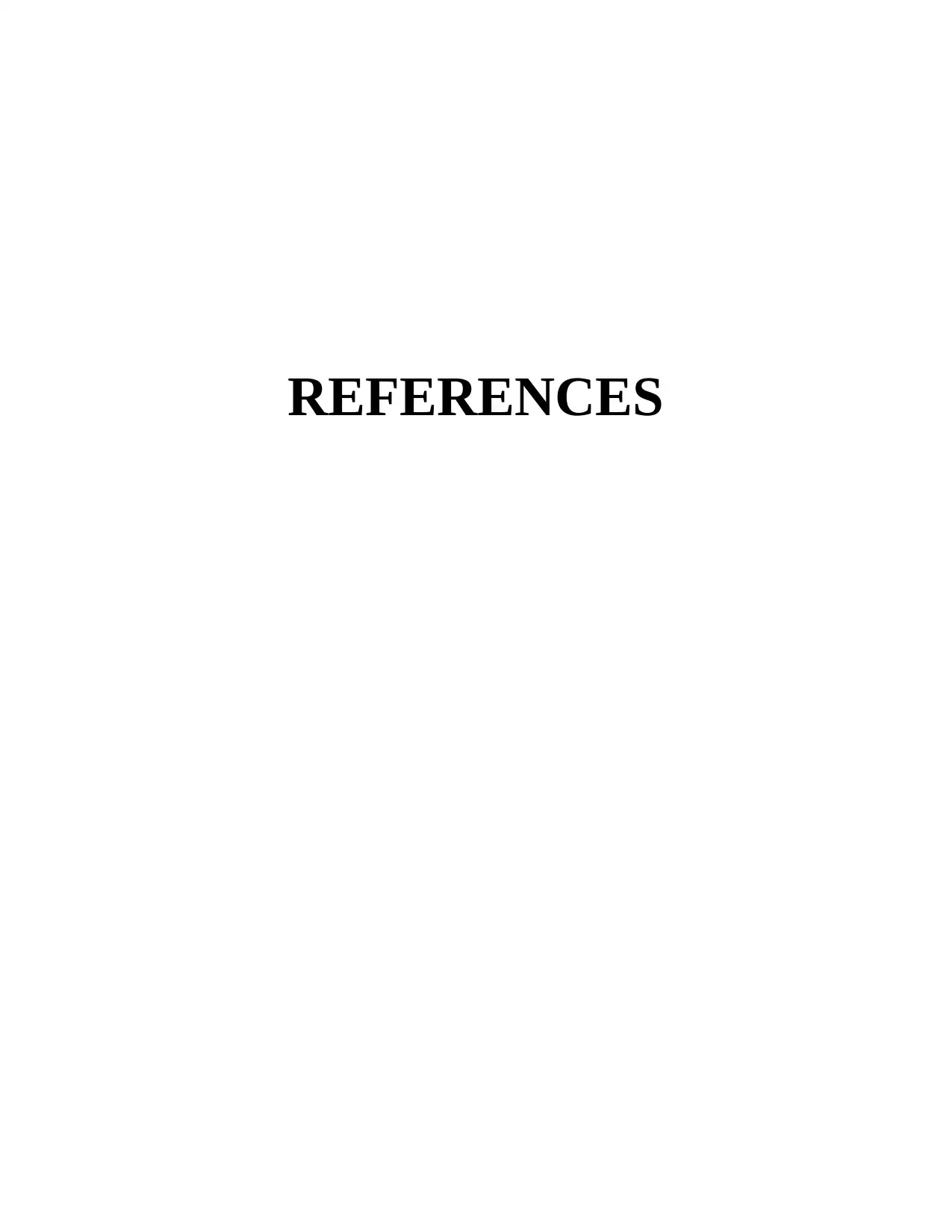
REFERENCES
Secure Best Marks with AI Grader
Need help grading? Try our AI Grader for instant feedback on your assignments.
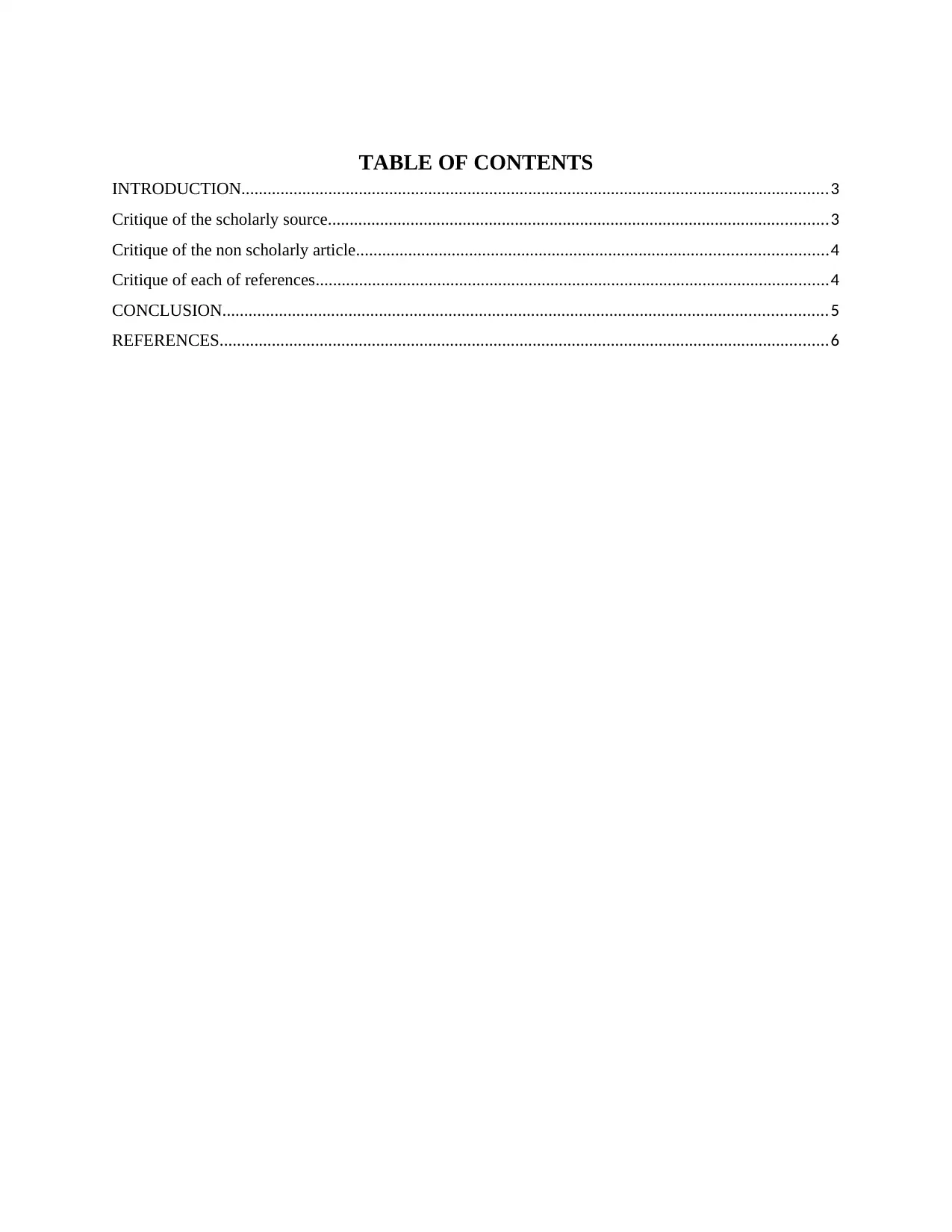
TABLE OF CONTENTS
INTRODUCTION.......................................................................................................................................3
Critique of the scholarly source...................................................................................................................3
Critique of the non scholarly article............................................................................................................4
Critique of each of references......................................................................................................................4
CONCLUSION...........................................................................................................................................5
REFERENCES............................................................................................................................................6
INTRODUCTION.......................................................................................................................................3
Critique of the scholarly source...................................................................................................................3
Critique of the non scholarly article............................................................................................................4
Critique of each of references......................................................................................................................4
CONCLUSION...........................................................................................................................................5
REFERENCES............................................................................................................................................6
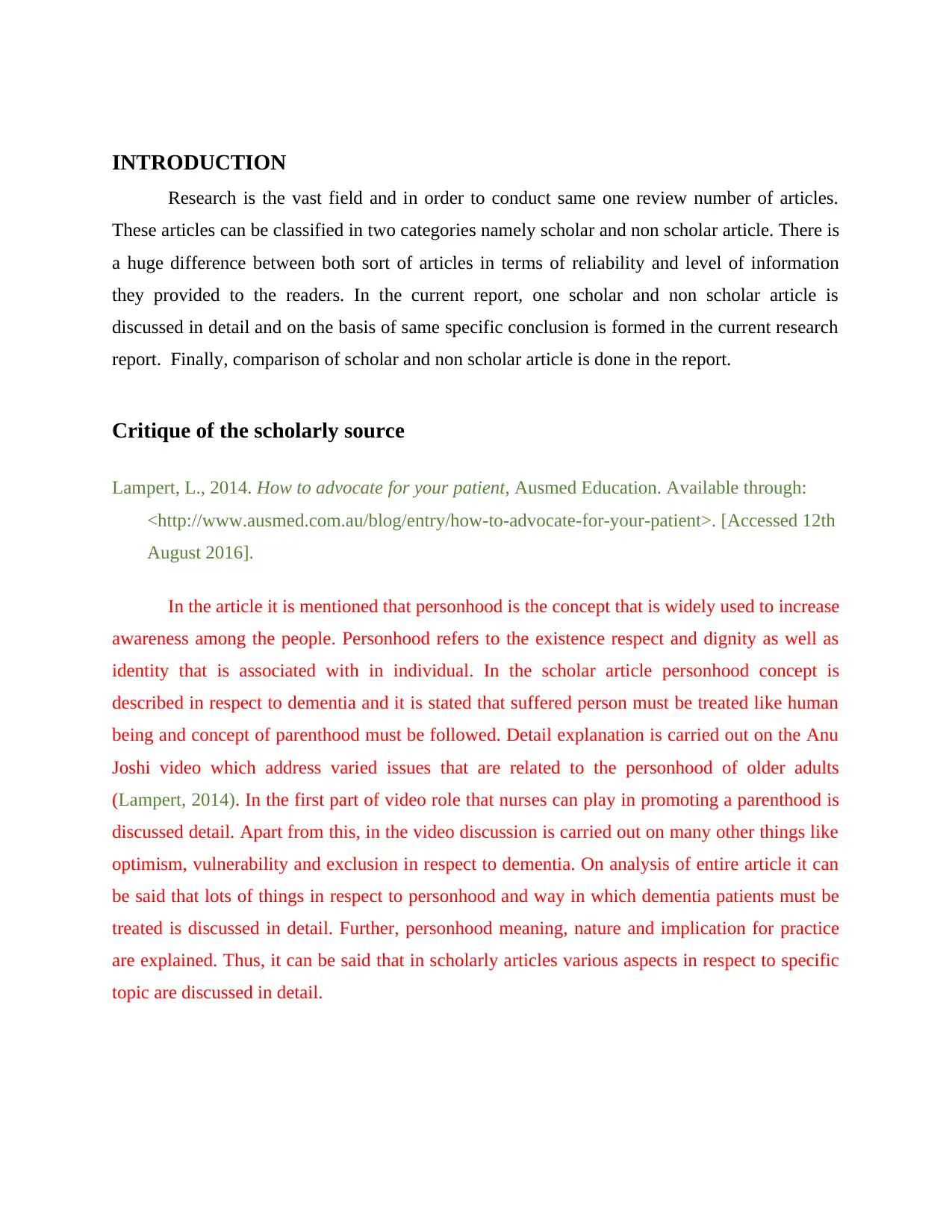
INTRODUCTION
Research is the vast field and in order to conduct same one review number of articles.
These articles can be classified in two categories namely scholar and non scholar article. There is
a huge difference between both sort of articles in terms of reliability and level of information
they provided to the readers. In the current report, one scholar and non scholar article is
discussed in detail and on the basis of same specific conclusion is formed in the current research
report. Finally, comparison of scholar and non scholar article is done in the report.
Critique of the scholarly source
Lampert, L., 2014. How to advocate for your patient, Ausmed Education. Available through:
<http://www.ausmed.com.au/blog/entry/how-to-advocate-for-your-patient>. [Accessed 12th
August 2016].
In the article it is mentioned that personhood is the concept that is widely used to increase
awareness among the people. Personhood refers to the existence respect and dignity as well as
identity that is associated with in individual. In the scholar article personhood concept is
described in respect to dementia and it is stated that suffered person must be treated like human
being and concept of parenthood must be followed. Detail explanation is carried out on the Anu
Joshi video which address varied issues that are related to the personhood of older adults
(Lampert, 2014). In the first part of video role that nurses can play in promoting a parenthood is
discussed detail. Apart from this, in the video discussion is carried out on many other things like
optimism, vulnerability and exclusion in respect to dementia. On analysis of entire article it can
be said that lots of things in respect to personhood and way in which dementia patients must be
treated is discussed in detail. Further, personhood meaning, nature and implication for practice
are explained. Thus, it can be said that in scholarly articles various aspects in respect to specific
topic are discussed in detail.
Research is the vast field and in order to conduct same one review number of articles.
These articles can be classified in two categories namely scholar and non scholar article. There is
a huge difference between both sort of articles in terms of reliability and level of information
they provided to the readers. In the current report, one scholar and non scholar article is
discussed in detail and on the basis of same specific conclusion is formed in the current research
report. Finally, comparison of scholar and non scholar article is done in the report.
Critique of the scholarly source
Lampert, L., 2014. How to advocate for your patient, Ausmed Education. Available through:
<http://www.ausmed.com.au/blog/entry/how-to-advocate-for-your-patient>. [Accessed 12th
August 2016].
In the article it is mentioned that personhood is the concept that is widely used to increase
awareness among the people. Personhood refers to the existence respect and dignity as well as
identity that is associated with in individual. In the scholar article personhood concept is
described in respect to dementia and it is stated that suffered person must be treated like human
being and concept of parenthood must be followed. Detail explanation is carried out on the Anu
Joshi video which address varied issues that are related to the personhood of older adults
(Lampert, 2014). In the first part of video role that nurses can play in promoting a parenthood is
discussed detail. Apart from this, in the video discussion is carried out on many other things like
optimism, vulnerability and exclusion in respect to dementia. On analysis of entire article it can
be said that lots of things in respect to personhood and way in which dementia patients must be
treated is discussed in detail. Further, personhood meaning, nature and implication for practice
are explained. Thus, it can be said that in scholarly articles various aspects in respect to specific
topic are discussed in detail.
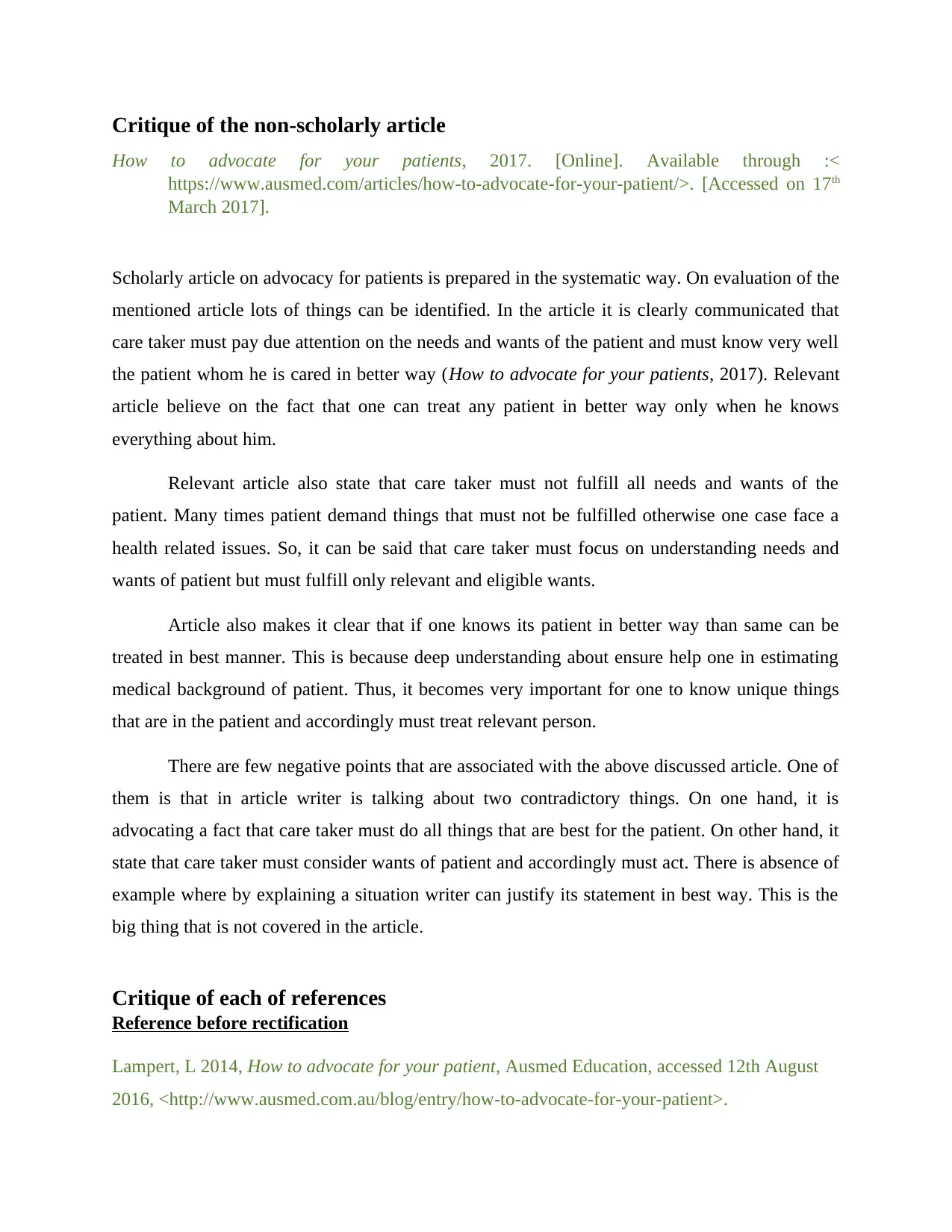
Critique of the non-scholarly article
How to advocate for your patients, 2017. [Online]. Available through :<
https://www.ausmed.com/articles/how-to-advocate-for-your-patient/>. [Accessed on 17th
March 2017].
Scholarly article on advocacy for patients is prepared in the systematic way. On evaluation of the
mentioned article lots of things can be identified. In the article it is clearly communicated that
care taker must pay due attention on the needs and wants of the patient and must know very well
the patient whom he is cared in better way (How to advocate for your patients, 2017). Relevant
article believe on the fact that one can treat any patient in better way only when he knows
everything about him.
Relevant article also state that care taker must not fulfill all needs and wants of the
patient. Many times patient demand things that must not be fulfilled otherwise one case face a
health related issues. So, it can be said that care taker must focus on understanding needs and
wants of patient but must fulfill only relevant and eligible wants.
Article also makes it clear that if one knows its patient in better way than same can be
treated in best manner. This is because deep understanding about ensure help one in estimating
medical background of patient. Thus, it becomes very important for one to know unique things
that are in the patient and accordingly must treat relevant person.
There are few negative points that are associated with the above discussed article. One of
them is that in article writer is talking about two contradictory things. On one hand, it is
advocating a fact that care taker must do all things that are best for the patient. On other hand, it
state that care taker must consider wants of patient and accordingly must act. There is absence of
example where by explaining a situation writer can justify its statement in best way. This is the
big thing that is not covered in the article.
Critique of each of references
Reference before rectification
Lampert, L 2014, How to advocate for your patient, Ausmed Education, accessed 12th August
2016, <http://www.ausmed.com.au/blog/entry/how-to-advocate-for-your-patient>.
How to advocate for your patients, 2017. [Online]. Available through :<
https://www.ausmed.com/articles/how-to-advocate-for-your-patient/>. [Accessed on 17th
March 2017].
Scholarly article on advocacy for patients is prepared in the systematic way. On evaluation of the
mentioned article lots of things can be identified. In the article it is clearly communicated that
care taker must pay due attention on the needs and wants of the patient and must know very well
the patient whom he is cared in better way (How to advocate for your patients, 2017). Relevant
article believe on the fact that one can treat any patient in better way only when he knows
everything about him.
Relevant article also state that care taker must not fulfill all needs and wants of the
patient. Many times patient demand things that must not be fulfilled otherwise one case face a
health related issues. So, it can be said that care taker must focus on understanding needs and
wants of patient but must fulfill only relevant and eligible wants.
Article also makes it clear that if one knows its patient in better way than same can be
treated in best manner. This is because deep understanding about ensure help one in estimating
medical background of patient. Thus, it becomes very important for one to know unique things
that are in the patient and accordingly must treat relevant person.
There are few negative points that are associated with the above discussed article. One of
them is that in article writer is talking about two contradictory things. On one hand, it is
advocating a fact that care taker must do all things that are best for the patient. On other hand, it
state that care taker must consider wants of patient and accordingly must act. There is absence of
example where by explaining a situation writer can justify its statement in best way. This is the
big thing that is not covered in the article.
Critique of each of references
Reference before rectification
Lampert, L 2014, How to advocate for your patient, Ausmed Education, accessed 12th August
2016, <http://www.ausmed.com.au/blog/entry/how-to-advocate-for-your-patient>.
Secure Best Marks with AI Grader
Need help grading? Try our AI Grader for instant feedback on your assignments.
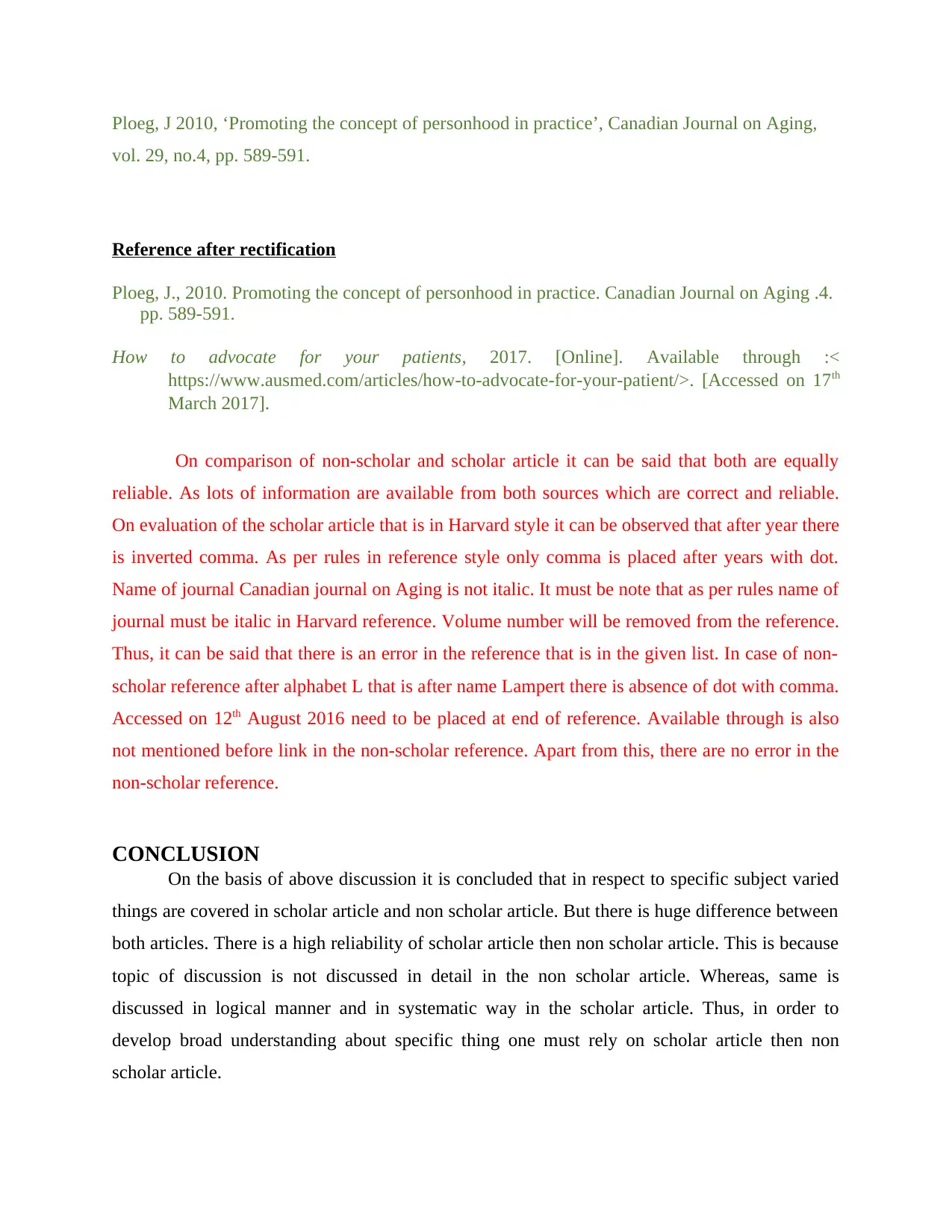
Ploeg, J 2010, ‘Promoting the concept of personhood in practice’, Canadian Journal on Aging,
vol. 29, no.4, pp. 589-591.
Reference after rectification
Ploeg, J., 2010. Promoting the concept of personhood in practice. Canadian Journal on Aging .4.
pp. 589-591.
How to advocate for your patients, 2017. [Online]. Available through :<
https://www.ausmed.com/articles/how-to-advocate-for-your-patient/>. [Accessed on 17th
March 2017].
On comparison of non-scholar and scholar article it can be said that both are equally
reliable. As lots of information are available from both sources which are correct and reliable.
On evaluation of the scholar article that is in Harvard style it can be observed that after year there
is inverted comma. As per rules in reference style only comma is placed after years with dot.
Name of journal Canadian journal on Aging is not italic. It must be note that as per rules name of
journal must be italic in Harvard reference. Volume number will be removed from the reference.
Thus, it can be said that there is an error in the reference that is in the given list. In case of non-
scholar reference after alphabet L that is after name Lampert there is absence of dot with comma.
Accessed on 12th August 2016 need to be placed at end of reference. Available through is also
not mentioned before link in the non-scholar reference. Apart from this, there are no error in the
non-scholar reference.
CONCLUSION
On the basis of above discussion it is concluded that in respect to specific subject varied
things are covered in scholar article and non scholar article. But there is huge difference between
both articles. There is a high reliability of scholar article then non scholar article. This is because
topic of discussion is not discussed in detail in the non scholar article. Whereas, same is
discussed in logical manner and in systematic way in the scholar article. Thus, in order to
develop broad understanding about specific thing one must rely on scholar article then non
scholar article.
vol. 29, no.4, pp. 589-591.
Reference after rectification
Ploeg, J., 2010. Promoting the concept of personhood in practice. Canadian Journal on Aging .4.
pp. 589-591.
How to advocate for your patients, 2017. [Online]. Available through :<
https://www.ausmed.com/articles/how-to-advocate-for-your-patient/>. [Accessed on 17th
March 2017].
On comparison of non-scholar and scholar article it can be said that both are equally
reliable. As lots of information are available from both sources which are correct and reliable.
On evaluation of the scholar article that is in Harvard style it can be observed that after year there
is inverted comma. As per rules in reference style only comma is placed after years with dot.
Name of journal Canadian journal on Aging is not italic. It must be note that as per rules name of
journal must be italic in Harvard reference. Volume number will be removed from the reference.
Thus, it can be said that there is an error in the reference that is in the given list. In case of non-
scholar reference after alphabet L that is after name Lampert there is absence of dot with comma.
Accessed on 12th August 2016 need to be placed at end of reference. Available through is also
not mentioned before link in the non-scholar reference. Apart from this, there are no error in the
non-scholar reference.
CONCLUSION
On the basis of above discussion it is concluded that in respect to specific subject varied
things are covered in scholar article and non scholar article. But there is huge difference between
both articles. There is a high reliability of scholar article then non scholar article. This is because
topic of discussion is not discussed in detail in the non scholar article. Whereas, same is
discussed in logical manner and in systematic way in the scholar article. Thus, in order to
develop broad understanding about specific thing one must rely on scholar article then non
scholar article.
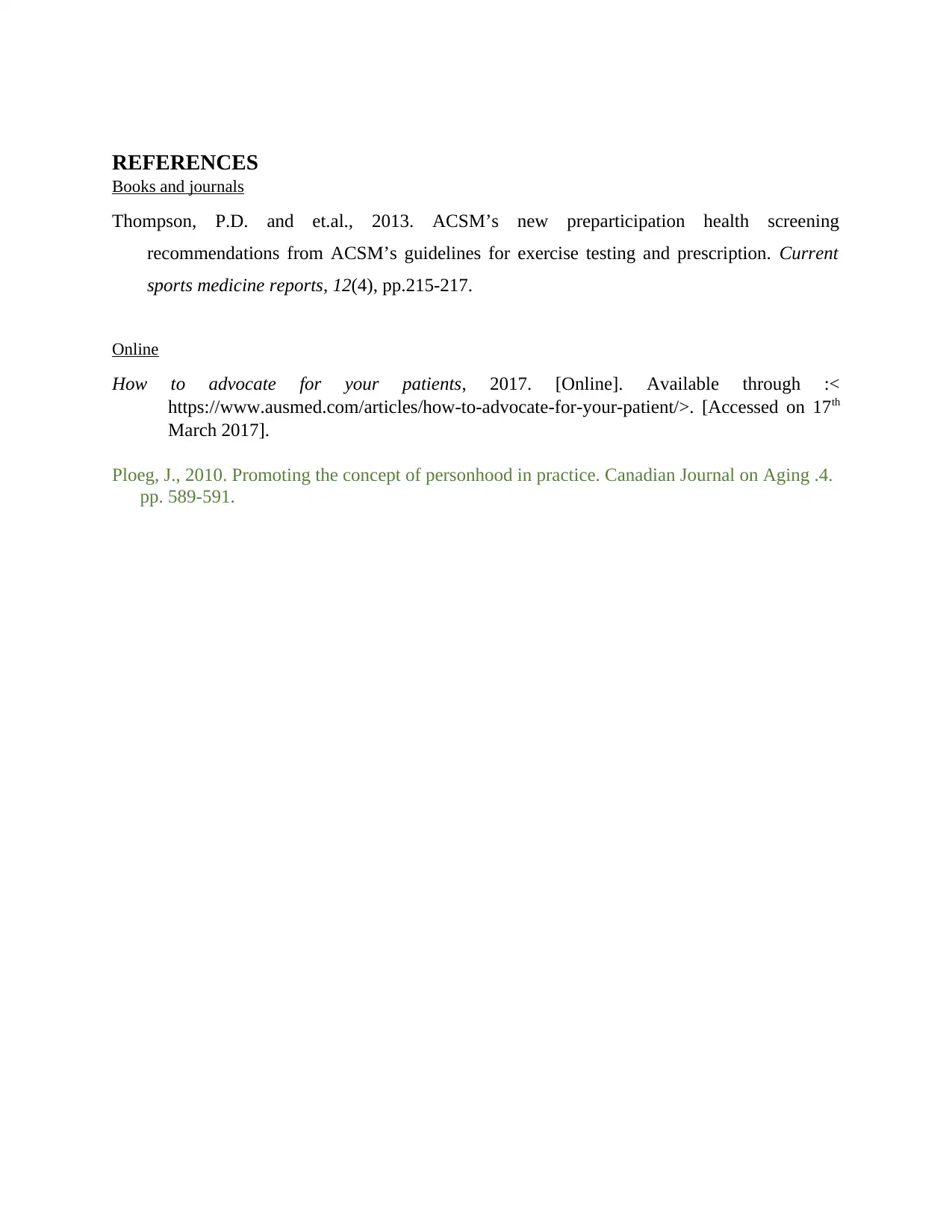
REFERENCES
Books and journals
Thompson, P.D. and et.al., 2013. ACSM’s new preparticipation health screening
recommendations from ACSM’s guidelines for exercise testing and prescription. Current
sports medicine reports, 12(4), pp.215-217.
Online
How to advocate for your patients, 2017. [Online]. Available through :<
https://www.ausmed.com/articles/how-to-advocate-for-your-patient/>. [Accessed on 17th
March 2017].
Ploeg, J., 2010. Promoting the concept of personhood in practice. Canadian Journal on Aging .4.
pp. 589-591.
Books and journals
Thompson, P.D. and et.al., 2013. ACSM’s new preparticipation health screening
recommendations from ACSM’s guidelines for exercise testing and prescription. Current
sports medicine reports, 12(4), pp.215-217.
Online
How to advocate for your patients, 2017. [Online]. Available through :<
https://www.ausmed.com/articles/how-to-advocate-for-your-patient/>. [Accessed on 17th
March 2017].
Ploeg, J., 2010. Promoting the concept of personhood in practice. Canadian Journal on Aging .4.
pp. 589-591.
1 out of 6
Your All-in-One AI-Powered Toolkit for Academic Success.
+13062052269
info@desklib.com
Available 24*7 on WhatsApp / Email
![[object Object]](/_next/static/media/star-bottom.7253800d.svg)
Unlock your academic potential
© 2024 | Zucol Services PVT LTD | All rights reserved.